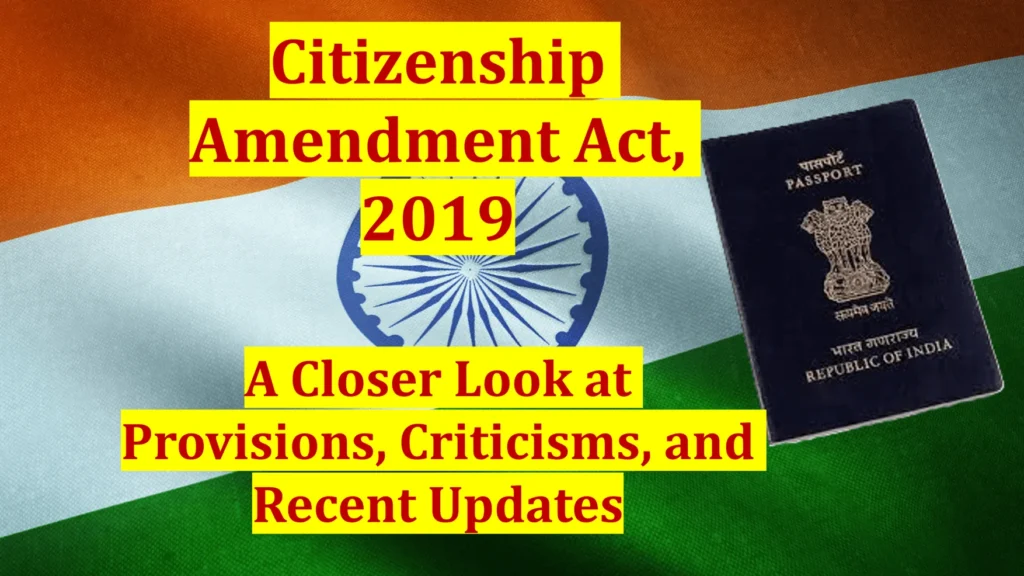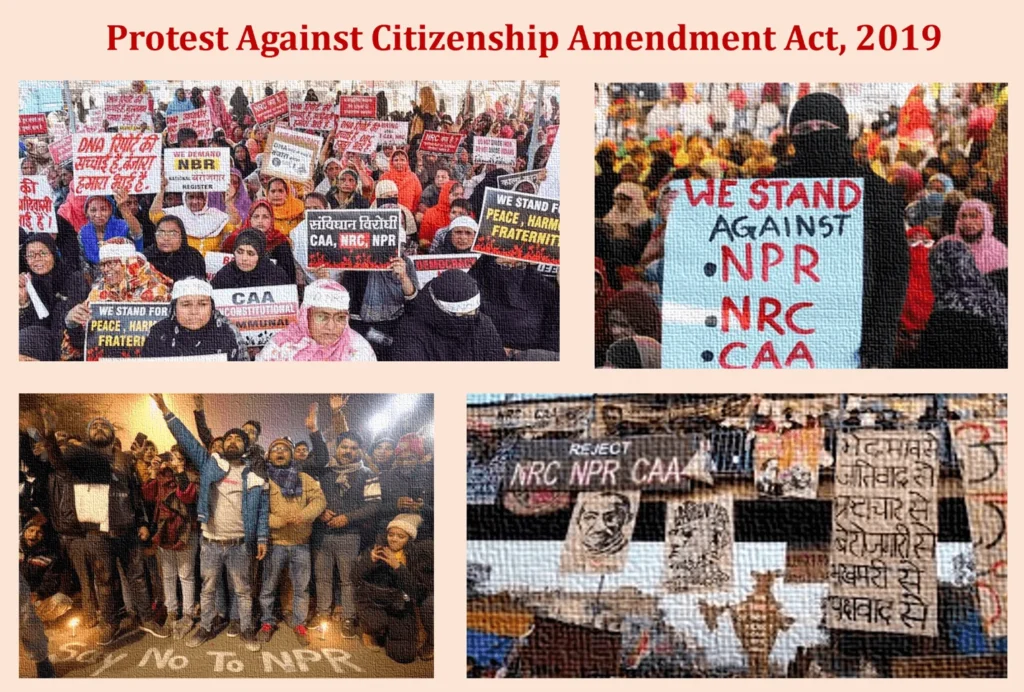
Introduction
The Central government officially announced the rules for the implementation of Citizenship Amendment Act, 2019 on 11th March,2024, marking a significant milestone approximately four years after the controversial law was passed. Stringent security measures were observed in various parts of Delhi, particularly in the northeastern areas such as Shaheen Bagh, where paramilitary personnel conducted night patrols and flag marches.
Background and Context
The Indian Parliament passed the Citizenship Amendment Act, 2019 on December 11, 2019. The bill aimed to expedite the acquisition of Indian citizenship for specific religious minorities facing persecution in Pakistan, Afghanistan, and Bangladesh. This move, however, excluded Muslims, sparking widespread protests across the nation.
The protests, notably in Delhi, gained momentum throughout 2019-2020, with Jamia Millia Islamia and Shaheen Bagh emerging as focal points of dissent. The situation escalated into communal riots in early 2020, resulting in substantial casualties and injuries.
Provisions of the Citizenship Amendment Act, 2019
The CAA amended the Citizenship Act of 1955, offering an accelerated pathway to Indian citizenship for persecuted religious minorities from specified neighboring countries. The eligible minorities included Hindus, Sikhs, Buddhists, Jains, Parsis, or Christians, while Muslims were excluded from this provision.
The amendment drew global criticism for its overt use of religion as a criterion for citizenship, marking a departure from India’s secular principles
Under the 2019 amendment, migrants who entered India by December 31, 2014, and faced “religious persecution or fear of religious persecution” in their home countries were deemed eligible for accelerated citizenship. The residence requirement for naturalization was reduced from twelve years to six, benefiting over 30,000 immediate beneficiaries, as per Intelligence Bureau records.
Criticism and Response
Critics denounced the amendment as discriminatory, particularly for excluding Muslims. The Office of the High Commissioner for Human Rights (OHCHR) labeled it “fundamentally discriminatory,” advocating for a non-discriminatory asylum system.
Concerns were raised regarding the potential use of the CAA, along with the National Register of Citizens (NRC), to render many Muslim citizens stateless, due to stringent birth or identity proof requirements. Moreover, critics questioned the exclusion of persecuted religious minorities from regions like Tibet, Sri Lanka, and Myanmar.
Recent Developments
On March 11, 2024, the Ministry of Home Affairs officially announced the rules for the Citizenship Amendment Act, fulfilling Union Home Minister Amit Shah’s commitment to implement them before the 2024 national elections. The announcement comes amidst continued debates and protests surrounding the CAA, reflecting the ongoing complexities and controversies surrounding India’s citizenship laws.
Evolving Dynamics of Indian Citizenship Law
The Indian Constitution, enacted in 1950, initially ensured citizenship to all residents without religious discrimination. Subsequent to this, the Citizenship Act of 1955 provided a framework for citizenship acquisition, encompassing those born in India along with specified pathways for foreigners to attain citizenship. However, the political landscape in the 1980s, notably the Assam movement against Bangladeshi migrants, prompted revisions to the Citizenship Act.
Amendments and Policy Shifts
Over the years, the Citizenship Act underwent several amendments, notably in 1992, 2003, 2005, and 2015. The pivotal Citizenship Amendment Act of 2003 introduced the concept of “illegal immigrants,” rendering them ineligible for citizenship and subjecting them to deportation or imprisonment. This amendment also mandated the establishment of a National Register of Citizens.
The political discourse surrounding citizenship, especially concerning minority communities from neighboring countries, gained prominence. The 2003 amendment received bipartisan support, reflecting concerns over religious persecution in countries like Bangladesh.
Immigration Landscape and Policy Void
India grapples with a significant influx of illegal immigrants, predominantly from Bangladesh. Estimates suggest millions of illegal migrants residing in the country, primarily due to porous borders and historical migration patterns. The absence of a national refugee policy complicates the legal status of refugees, categorizing all as “illegal migrants.”

Despite hosting a considerable refugee population, India remains non-signatory to international refugee conventions, adhering to a traditional stance advocating for eventual repatriation.
National Register of Citizens and Controversies
The implementation of the National Register of Citizens (NRC) in Assam underscored challenges in determining citizenship status. The process, marred by controversies and exclusions, highlighted the complexities of identity and migration in the region.
As the government contemplates nationwide implementation of the NRC, debates intensify over its implications on minority communities and indigenous populations. India’s citizenship landscape reflects a complex interplay of historical legacies, political agendas, and humanitarian considerations. As the nation navigates these intricacies, the quest for inclusive and equitable citizenship remains a pertinent issue in its democratic framework.
Tracing the Legislative Journey of Citizenship Amendments
The evolution of India’s citizenship laws, particularly in recent years, reflects the intricate interplay between political agendas, regional dynamics, and humanitarian concerns. Here’s a chronological overview of the legislative history surrounding citizenship amendments:
Introduction of Citizenship Amendment Bill, 2016
In 2016, the Government of India initiated efforts to amend the citizenship law. The proposed bill aimed to extend Indian citizenship to non-Muslim migrants from Pakistan, Afghanistan, and Bangladesh. While the bill secured passage in the Lok Sabha, it faced staunch opposition and protests in the northeastern states, stalling its progress in the Rajya Sabha.
Renewed Commitment and Drafting of Citizenship Amendment Bill, 2019
Reaffirming its commitment to amend citizenship laws, the BJP highlighted the plight of religious minorities facing persecution in neighboring Muslim-majority nations during its 2019 election campaign. Following the elections, the government crafted a revised bill, addressing concerns raised by the northeastern states. The revised bill excluded certain regions and tribal areas, aiming to expedite citizenship for refugees fleeing religious persecution.
Legislative Journey of Citizenship Amendment Bill, 2019
The Citizenship Amendment Bill, 2019, underwent a rigorous legislative process. It was introduced in the 17th Lok Sabha in December 2019, spearheaded by the Minister of Home Affairs, Amit Shah. Despite opposition attempts to delay proceedings, the bill garnered significant support, receiving passage in both the Lok Sabha and the Rajya Sabha.
Notification of Citizenship Amendment Act (CAA)

Following presidential assent on December 12, 2019, the bill officially transformed into the Citizenship Amendment Act (CAA). The act, which came into force on January 10, 2020, facilitated citizenship for Hindu, Sikh, Jain, Buddhist, Christian, and Parsi refugees from Afghanistan, Bangladesh, and Pakistan. Notably, specified illegal migrants from these countries were granted eligibility for citizenship, signaling a significant policy shift.
Implementation Rules of CAA
On March 11, 2024, the Ministry of Home Affairs took a significant step by notifying the rules for the implementation of the Citizenship Amendment Act. The rules delineate the pathway for eligible refugees to attain Indian citizenship, emphasizing the government’s commitment to humanitarian principles amidst complex regional dynamics.
In essence, the legislative trajectory of citizenship amendments reflects India’s evolving stance on refugee protection and inclusion, while also navigating intricate political and regional sensitivities.
Navigating the Act: Amendments and Provisions
The Citizenship Amendment Act of 2019 brought significant alterations to the Citizenship Act, 1955, reshaping the landscape of citizenship acquisition in India. The amendments introduced nuanced provisions, outlined as follows:
Inclusion of Exempted Classes
The Act amended Section 2, Sub-section (1) of the Citizenship Act, 1955, incorporating provisions to exempt certain individuals from the designation of illegal migrants. Specifically, individuals belonging to Hindu, Sikh, Buddhist, Jain, Parsi, or Christian communities from Afghanistan, Bangladesh, or Pakistan, who entered India on or before December 31, 2014, and received exemptions from the Central Government under specified clauses of relevant acts, were not to be treated as illegal migrants under the purview of the Act.
Introduction of Section 6B
A pivotal addition to the Citizenship Act came in the form of Section 6B, which pertains to naturalization procedures. The Central Government or its specified authority, under prescribed conditions, restrictions, and manner, gained the prerogative to grant certificates of registration or naturalization to individuals falling within the ambit of the aforementioned exemptions.
Definition of Exempted Classes
The Foreigners Amendment Order, 2015, which was issued under the Foreigners Act, 1946, originally described the “exempted” classifications of individuals. These individuals, categorized as belonging to minority communities in Bangladesh and Pakistan, were granted exemptions from the provisions of the Foreigners Act, 1946, based on specific circumstances related to religious persecution or fear thereof.
Expansion of Exemptions
Subsequent amendments in 2016 extended exemptions to individuals from Afghanistan, broadening the scope of eligibility under the Act. Notably, Section 6B(4) of the Act delineated exclusions, particularly in the tribal areas of Assam, Meghalaya, Mizoram, or Tripura, as specified in the Sixth Schedule to the Constitution. Additionally, areas covered under “The Inner Line” as notified under the Bengal Eastern Frontier Regulation, 1873, were exempted from the provisions of the Act.
In essence, the amendments introduced by the Citizenship Amendment Act of 2019 signify a nuanced approach to citizenship acquisition, reflecting the complex socio-political dynamics of India’s diverse landscape.
Unraveling the Citizenship Amendment Act: A Comprehensive Analysis
The Citizenship Amendment Act of 2019 heralded significant changes to the existing legal framework, aiming to redefine the parameters of Indian citizenship. Here’s a detailed examination of its provisions and the intricate dynamics surrounding its implementation:
Provisions and Eligibility Criteria
The Act extends eligibility for Indian citizenship to persecuted minorities, including Hindus, Sikhs, Buddhists, Jains, Parsis, and Christians, from Afghanistan, Bangladesh, and Pakistan, provided they entered India on or before December 31, 2014. Notably, the Act conspicuously excludes Muslims from its ambit, a decision that has drawn sharp criticism and sparked debates surrounding its underlying rationale.
According to intelligence reports, immediate beneficiaries of the amended Act are estimated to be 31,313 individuals, comprising primarily Hindus, Sikhs, Christians, Buddhists, and Parsis.
Amendments to Naturalization Process
The Act introduces modifications to the naturalization process, reducing the residency requirement from 11 years to 5 years for individuals belonging to the aforementioned religious communities and originating from the specified countries. Additionally, tribal areas of Assam, Meghalaya, and Tripura, along with regions governed by the Inner Line Permit, are exempted from the Act’s applicability.
Moreover, a novel provision empowers authorities to cancel the registration of Overseas Citizenship of India (OCI) in case of violations of Indian laws, albeit with the provision for the OCI holder to present their case before a verdict is reached.
Exclusionary Dynamics and Criticisms
The Act’s exclusion of persecuted Muslims from Pakistan, Bangladesh, and Afghanistan has triggered widespread condemnation, with critics decrying it as a manifestation of anti-Islamic sentiment. While the Indian government justifies the exclusion citing constitutional provisions in the respective countries, concerns linger over the plight of marginalized Muslim communities, such as the Ahmadiyyas and Hazaras.
Furthermore, the Act’s failure to address refugees from non-Muslim countries, including Hindu refugees from Sri Lanka and Buddhist refugees from Tibet, has underscored its selective approach to humanitarian relief, drawing scrutiny from international observers.
Relationship to National Register of Citizens (NRC)
The Act’s interplay with the National Register of Citizens (NRC) has sparked apprehensions regarding its potential to exacerbate divisions and target Muslim communities. While government officials have offered reassurances regarding the NRC process, concerns persist over its implications for minority populations, heightening tensions and amplifying calls for transparency and accountability.
In essence, the Citizenship Amendment Act of 2019 encapsulates the complexities of India’s socio-political landscape, prompting introspection and debate on the principles of inclusivity, secularism, and human rights in the world’s largest democracy.
Interpreting the CAA: A Spectrum of Responses
The enactment of the Citizenship Amendment Act (CAA) stirred a maelstrom of reactions, resonating with protests, political maneuvers, and legal challenges. Here’s a nuanced exploration of the diverse receptions and repercussions surrounding the controversial legislation:
Protests: Voices of Dissent and Discord
In Assam, the passage of the Act kindled fierce protests, with demonstrators citing violations of prior agreements and cultural erosion. The cancellation of the India-Japan summit underscored the gravity of the unrest, prompting global advisories cautioning against travel to India’s northeast.

Across the nation, dissenters rallied against what they perceived as the marginalization of Muslims and a departure from India’s secular ethos. Metropolitan cities became epicenters of both physical and virtual dissent, with social media platforms amplifying critiques of the BJP-led government’s policies.
International Outcry: Global Solidarity and Discord
Beyond Indian borders, cities worldwide reverberated with protests denouncing the Act and condemning instances of police brutality. International scrutiny intensified, with comparisons drawn to historical precedents like the Reich citizenship law, signaling growing apprehensions about democratic erosion and communal tensions in India.
Student Mobilization: Catalysts for Change
Students from diverse universities spearheaded protests, symbolizing a resolute commitment to uphold India’s secular fabric. Instances of police crackdowns at universities like Jamia Millia Islamia ignited nationwide outrage, underscoring the power of youth-led movements in shaping the discourse on citizenship rights.
Political and Legal Controversies: Challenges and Contradictions
Opposition from political quarters, including the Indian National Congress and various state governments, underscored deep-seated concerns about communal polarization and constitutional integrity. Legal battles ensued, with petitions challenging the Act’s legality and constitutional validity.
Refugee Perspectives: Hope, Fear, and Uncertainty
While some refugee communities expressed optimism about the Act’s potential to secure their citizenship, others harbored apprehensions about exclusion and deportation. The plight of Rohingya Muslims highlighted broader anxieties about statelessness and vulnerability in the face of shifting political landscapes.
International Commentary: Diplomatic Strains and Societal Divides
Foreign intelligence agencies voiced reservations, cautioning against diplomatic fallout and espionage risks. Intellectual discourse reflected a spectrum of opinions, with proponents lauding the Act’s humanitarian intent while critics condemned its exclusionary implications.
In essence, the Citizenship Amendment Act emerges as a crucible of contention, exposing fault lines and fissures within India’s socio-political fabric. As protests persist and legal battles unfold, the Act’s enduring legacy continues to shape narratives of identity, justice, and democratic governance in the world’s largest democracy.
Global Perspectives on CAA
The enactment of India’s Citizenship Amendment Act (CAA) has elicited a spectrum of responses from nations and international organizations, reflecting diverse opinions and concerns regarding the legislation. Here’s a comprehensive overview of the international reactions to the CAA:
- Afghanistan: Former President Hamid Karzai urged India to uphold equality for all minorities, emphasizing the challenges faced by all religious communities in Afghanistan amidst ongoing conflict.
- Australia: Australian Greens MP David Shoebridge raised concerns about the CAA and called for a reassessment of trade agreements with India to incorporate human rights considerations.
- Bahrain: The Shura Council advocated for the rights of Muslims and urged India to reconsider the implementation of the Act, underscoring the importance of respecting international principles.
- Bangladesh: Bangladesh’s Minister of Foreign Affairs expressed reservations about the CAA, suggesting that it could compromise India’s secular identity and denying claims of religious persecution in Bangladesh.
- France: France’s Ambassador to India maintained that the CAA is India’s internal affair, emphasizing respect for India’s sovereignty.
- Kuwait: Kuwaiti lawmakers expressed deep concern over India’s treatment of Muslims and called for diplomatic efforts to address the situation.
- Malaysia: Prime Minister Mahathir Mohamad criticized the CAA, expressing concerns about potential citizenship deprivation for Muslims.
- Maldives: Maldives’ Parliament Speaker affirmed the democratic passage of the CAA while asserting its status as India’s internal matter.
- Pakistan: Pakistan’s government and lawmakers condemned the Act, labeling it discriminatory and contrary to bilateral agreements on minority rights.
- Russia: Russia’s Deputy Ambassador to India reiterated Russia’s stance on the CAA as India’s internal matter.
- Sri Lanka: Prime Minister Mahinda Rajapaksa considered the CAA as India’s internal affair and affirmed Sri Lanka’s willingness to welcome Tamil refugees.
- United Kingdom: The British High Commissioner expressed hope for addressing public concerns in line with India’s commitment to inclusive development.
- United States: The US Commission on International Religious Freedom (USCIRF) called for sanctions against Indian leaders over the CAA, while the US House Committee on Foreign Affairs questioned its intent. President Donald Trump refrained from direct comment during his visit to India.
Organizational Responses
- European Union: The EU Ambassador expressed trust in India’s constitutional standards.
- Organization of Islamic Cooperation: The OIC voiced concerns and urged India to safeguard Muslim minority rights.
- United Nations: The UN High Commissioner for Human Rights criticized the Act as discriminatory and filed an intervention in the Supreme Court of India.
In sum, the international response underscores the complex implications of the Citizenship Amendment Act, reflecting broader debates on human rights, democracy, and religious freedom on the global stage.
Conclusion & FAQs
The text outlines the legislative journey, provisions, criticisms, recent developments, and international perspectives surrounding the Citizenship Amendment Act, 2019 in India. The Act, aimed at granting expedited citizenship to persecuted minorities from specific neighboring countries, excluding Muslims, has sparked widespread protests and international scrutiny. The document delves into the complex interplay of political agendas, regional dynamics, and humanitarian concerns surrounding India’s citizenship landscape. It underscores the challenges and controversies inherent in navigating issues of religion, migration, and identity within India’s democratic framework.
Frequently Asked Questions (FAQs)
What is the Citizenship Amendment Act, 2019?
The Citizenship Amendment Act, 2019 is an Indian law that provides a pathway to Indian citizenship for specific religious minorities from Pakistan, Afghanistan, and Bangladesh, while excluding Muslims.
What are the criticisms of the Citizenship Amendment Act?
Critics argue that the Act discriminates against Muslims, violates India’s secular principles, and may render many Muslims stateless, particularly in conjunction with the National Register of Citizens (NRC).
How has the international community responded to the Citizenship Amendment Act?
International reactions range from expressions of concern over human rights violations to statements affirming India’s sovereignty and internal affairs. Some countries and organizations have criticized the Act for its discriminatory nature.
What are the recent developments regarding the implementation of the Citizenship Amendment Act?
The Ministry of Home Affairs officially announced the rules for the implementation of the Act on March 11, 2024, reflecting the government’s commitment to enforcing the law before the 2024 national elections.

Somebody essentially help to make significantly articles Id state This is the first time I frequented your web page and up to now I surprised with the research you made to make this actual post incredible Fantastic job